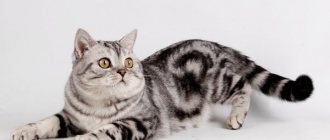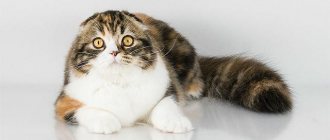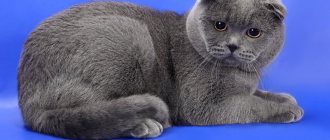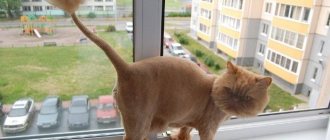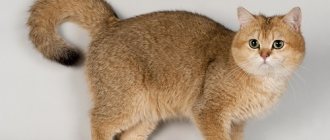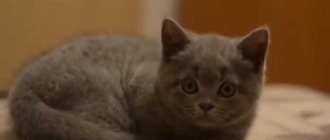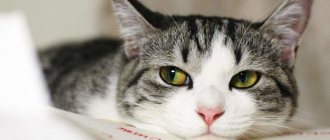The Scottish cat is an extremely popular breed. Its representatives live on average 15 years. There are some individuals that live up to 20 years or more. Thus, on average, the life expectancy of Scottish fold and straight-eared cats and cats is approximately the same as that of other breeds.
But this only concerns the question of how long Scottish cats and fold-eared and straight-eared cats live at home. Such a tailed animal will live much less on the street, and here's why. At home, the food is better, the care is better, the veterinarian is available when needed, affection and care are all around.
Article continues after advertisement
Another significant factor is the birth of kittens. Sterile cats have a much longer life expectancy, this has been proven by scientists. Animals that are not neutered live shorter lives on average. But, if a cat periodically gives birth to kittens at home, this happens with better nutrition and medical care, and she does not do this as often as in nature, then she also has a good chance of living a long time. In street conditions, cats give birth 3-4 times a year, which depletes the body, and as a result, including this, life expectancy is only 5-7 years. This is normal, because otherwise we would have had an overpopulation of cats on our planet long ago.
How many years Scottish Fold cats (Scottish Folds and Highland Folds) live also depends on the presence or absence of musculoskeletal diseases. The thing is that fold-eared cats are predisposed to joint diseases, which can sometimes result in a serious problem. The culprit is the lop ear gene, which deforms the cartilage. Straights don't have this problem.
But let's not talk about the bad. Let's assume that you have chosen a healthy kitten, keep it in good conditions, groom it and cherish it in every possible way. Under such conditions, the life expectancy of Scottish fold cats can easily reach 20 years. To bring it closer to this mark, you need the following:
- choose the right breeder, buy a healthy kitten, preferably a girl, because... females live about 2 years longer than males;
- get all vaccinations on time, but only with high-quality vaccines;
- when a cat appears in the house, eliminate all dangers that may threaten its health;
- sterilize (castrate);
- do not let him go outside on his own;
- feed raw natural food according to a balanced menu or purchase the highest class food;
- take him to the veterinarian for examination on time;
- often play with the cat so that he has good physical activity;
- choose only high-quality and safe care items and toys;
- truly love your pet.
Subject to these conditions, you get the maximum chance that you will live happily ever after with your cat.
How to care for a kitten
After birth, caring for a Scottish kitten on a cat. He learns his first hygiene skills from his mother. It is the owner's responsibility to feed the adult animal.
1 month
The baby sleeps with the cat during this period of time. It is necessary to limit the area where the baby is: the fidget may fall or be frightened by sharp sounds.
Up to a month, the kitten is saturated with mother's milk: the baby will receive all the necessary elements. By 4 weeks, the little ward begins to gradually transfer to independent feeding. The bowl is placed next to the dish containing food for the cat.
The owner helps to get used to the new type of food: he brings the kitten to the plate, carefully lowers its face into the bowl so that it tastes the food. Then he watches them, making sure that the fidgets lick all the food. The feeding should be warm, each pet should have their own dishes. It is better to purchase special equipment for feeding. To begin with, add food up to 2 times a day. The rest of the time, the baby continues to drink cat milk.
2 month
From one and a half months, solid pieces are introduced into complementary foods. Before a two-month-old kitten moves into the house, a sleeping place is prepared for it. This can be a bed, in the form of a warm diaper, or a store-bought house with a round hole. Calm Scots love to hide there.
Having brought the animal into the house, it is given one room. Most often they choose the bathroom or kitchen. When the newly arrived family member gets comfortable, you need to gradually introduce him to the new home. It is advisable to buy a toilet tray with low sides and fill it with the filler that the former owner used. The door to the toilet is kept open.
Home life
Scottish Folds are definitely family pets. It would be hard for them on the street. Despite their good health, these are rather fragile creatures. They are easily susceptible to infections. Therefore, if the cat is lost, after finding it, you need to take the lost cat to the veterinarian for examination and vaccinations. At home, the cat should not be exposed to stress. Make sure that children do not harm the animal. This breed is very affectionate, so it often comes to cuddle and play. Respond to the love impulses of your pet, this is very important for her. A pleasant atmosphere in the house will relieve the cat from stress, and therefore prolong its life.
Scottish Fold cats are considered long-lived. A caring owner must surround the pet with attention and love in order to extend the years of the pet’s life. Caring includes not only games and affection, but also creating a proper diet, brushing, providing quality food, and trips to the veterinarian. After all, for a cat to be healthy, he needs to feel safe.
Hello, dear readers!
Cats in our world are perceived not as pets, but as family members. People often get representatives of rare decorative breeds, which may have features in terms of health and diet.
Owners care about how long Scottish Fold cats live and how to extend their lifespan.
Caring for an adult pet
An animal with the following signs is taken from the nursery:
- healthy;
- well-mannered;
- grafted.
But this does not mean that the cat’s manners are not worth working on. As the child grows up, he develops his own habits and character traits.
As the Scot grows, you have to change the container for the toilet, purchasing a tray with deeper walls. An adult animal can show its condition by behavior: meowing or marking corners and furniture.
Breeding should be carried out by experienced breeders, or owners who have studied and tested in practice all the nuances of crossing representatives of the breed. The sale of kittens is planned: you need to prepare to select a partner, preferably from the same club.
How long do cats live (sterilized and unsterilized at home)
Neutered Scottish Fold cats at home live longer than usual by an average of 3 years. There is an opinion that you need to let the cat know the joys of motherhood. This is not true: carrying a baby will weaken the body of an adult animal. A Scottish cat that is brought into the house as a pet is advised to be sterilized.
How long do cats live (neutered and non-castrated at home)
If the cat does not participate in a breeding career, you need to think about castration. After the operation there is no need to search for a female. But this event does not affect life expectancy in any way. Neutered pets live as long as their non-neutered counterparts.
Average life expectancy of a Scottish fold cat
There are many factors that influence a cat's life. You can't generalize about all cats, but you can still calculate their average lifespan. Scottish Folds are long-lived. With proper care and attention, they can live up to 20 years. For cats, this is quite an impressive period. It is noteworthy that females are hardier than males and live a couple of years longer. Those pets that are properly cared for can live twenty years. Many factors can affect a cat's health.
Caring for an old pet
The aging body of a Scottish cat is more susceptible to various diseases than young individuals. During this period of time, arthritis may develop, the pet’s behavior may change, and problems with the functioning of the stomach and intestines may arise.
To avoid problems, you should select food that is appropriate for the age of your pet. Conduct a preventive examination of the cat with a veterinarian and monitor the health and emotional state of the Scottish cat.
After a walk, the cat is checked for ticks and fleas. Often the Scots do not walk outside, they stay in the apartment, but if the pet is taken outside the house, a subsequent examination is necessary.
Proper nutrition and diet
A balanced diet is the key to health. Consult with a specialist to choose the right food for your cat. Good food contains all the necessary vitamins and you do not have to purchase additional vitamins. The food can treat some diseases common to cats of this breed. Don't experiment with Scotch's diet. After all, it directly affects the health of the pet. It is preferable to feed cats with high-quality food. Under no circumstances should natural food be mixed with feed. This is stressful for any cat's digestive system.
Appearance care.
It is necessary to create the necessary conditions for the life of a fold-eared cat:
- buy inventory;
- engage in education;
- feeding.
But caring for a purebred animal does not end there. Without taking care of the appearance, keeping a cat will not be complete.
Bathing
Despite the belief that cats, whether straight or fold, do not like to swim, many pets quickly get used to water procedures. It is important to ensure that the water is warm and does not get into the baby’s ears.
Breeders advise washing the Scottish Fold 3-4 times a year and whenever it gets dirty: if the animal has been walking and gets dirty. Pets performing at exhibitions are bathed immediately before the event. Use a specialized shampoo. Dry shampoo is used as a replacement for water procedures.
Nail trimming
From a young age, pets are taught to trim their claws.
Adult cats get used to the procedure and behave calmly. It is better for babies to cut their nails immediately after sleep: the baby will not worry and disturb the owner. Procedure:
- Firmly but carefully fix the kitten in your arms.
- Press on the pad of the paw.
- The baby stretches out its claws, and then the visible part is cut off without touching the skin.
Scissors are purchased in specialized departments and pet stores.
Grooming
The pet's fur is treated with a metal comb. It is necessary to comb the baby once a week, and during the molting period every day.
Appearance
British Fold is a Scottish breed of cat.
Scottish Folds have a fairly well-fed and powerful body. Cats come in different colors, the most popular being gray fur. The color of cats is divided into two groups: plain and patterned.
Patterned marbled color
Solid colors of fur are classified as monochromatic: white, black, gray, blue, red, chocolate, lilac.
The patterned colors include the following:
- spotted, round or oval-shaped spots on the back, sides and tail;
- marble, patterns in the form of a ring and a half ring;
- colorful, small spots and dots on the limbs and head, which are much darker and more contrasting against the background of the main color of the fur;
- chinchilla, a small part of the hairs is colored white or black, for example, completely blue cats may have white hairs on the abdomen or limbs.
Dimensions and weight of fold cats
Scottish cats are usually medium in size, but their bodies are stocky and muscular. The average weight of cats is about 4-7 kilograms, and cats are much heavier, ranging from 7 to 10 kg.
Ears
The ears are set wide on the head, “hanging” towards the bottom, but turned forward. They are small in size and rounded at the ends.
Eyes and nose
Large folded eyes with a perfect round shape. They are quite wide open, which gives the impression that the cat looks surprised.
The short nose is wide and straight. The animal has an excellent sense of smell, which makes British cats one of the best hunters among domestic cat breeds.
Torso and limbs
The chest, shoulders and back are wide compared to the rest of the body, the neck is short. The hind legs are short but muscular. The tail is also short and rounded at the tip.
Head
The cat's wide and massive head is shaped like a circle, and its chin is firm. The cheeks of a pet are wide and plump, in addition, the whisker pads are also round. The mustache is long and clearly defined.
British Folds love to stand on their hind legs.
What affects health
It is strictly forbidden to breed two fold-eared pets. As a result of such crossing, sick, weakened kittens are born. When purchasing, it is important to carefully study the cat’s pedigree and conduct an examination to identify possible defects and diseases.
At the first sign of illness, contact a veterinary clinic, where you must also obtain the animal’s vaccination schedule. We must not forget to monitor the condition of the ears: due to the peculiarities of their formation (ears are bent in half) and improper care, complications can arise. After bathing, you should not keep your baby in a draft.
Feeding
Choose the type of feeding:
- natural nutrition, this includes lean meats, fermented milk products, cereals and boiled vegetables;
- industrial food, for every age and specific situation (neutered cat, old cat, pregnant, lactating or kitten) there is its own option;
- mixed nutrition.
Many experts do not welcome a mixed diet. It is recommended to choose a natural or factory-made option for feeding Scottish Fold kittens.
Scottish Straight Longhair Highland Straight cat
Hygiene
Even small kittens that have not been taken from their mother have their eyes and muzzle washed and their ears cleaned. The eyes are wiped with a cotton pad soaked in ordinary warm water. Change the tampon and wipe your nose and mouth.
For the ear cleansing procedure, buy a special oil or use baby oil for the body. Dipping a cotton swab into the liquid (the bottle should be warm), carefully, without penetrating deep into the ear, treat the outside. The baby usually doesn’t like manipulation, but over time he will get used to it and sit quietly.
What ailments are there?
Diseases significantly shorten the life of fold-eared cats, so they may not live long depending on the disease. The most common:
- Osteochondrodysplasia. Characterized by skeletal deformation. Highland Fold and Scottish Fold breeds are at high risk of getting the disease. Straight-eared people are less susceptible. Proper treatment and care stops the disease and the cat can live to an old age.
- Hemophilia types A and B. Characterized by a blood clotting disorder and prolonged bleeding at the site of even a small cut. How many years Scottish cats with this diagnosis live depends on other anomalies of the body, since internal bleeding leads to rapid death.
- Eye diseases. A fold-eared or straight-eared cat often suffers from eversion or inversion of the eyelids, which provokes conjunctivitis, keratitis or blepharitis. Eye diseases do not affect a cat’s life expectancy if you consult a veterinarian in a timely manner and stop the inflammation.
- Ear ailments. The most common are otitis media, deafness and tumors due to the abnormal structure of the hearing organ. With proper care, your cat will live a long time. However, if the neoplasm is malignant, metastases may form and life expectancy will be significantly reduced.
- Deterioration of immunity. Pedigree cats have reduced body defenses, so they are susceptible to viral and bacterial diseases. Serious diseases (panleukopenia, rhinotracheitis) can “take away” your pet much earlier than expected.
- Metabolic disease. Spayed and neutered pets who suffer from hormonal imbalance suffer the most. This leads to obesity or diabetes.
Return to contents
Active lifestyle
From the first days of being at home, the baby is playful and cheerful. Up to a year old, the cubs actively use various toys, then the animal matures and becomes calmer
Scottish Straight and Fold pets are most often not prone to depression. But it is important not to let the animal lie for a long time. A sedentary lifestyle will lead to weight gain for your pet, and extra pounds are considered an additional burden on the cat’s internal organs.
- Cat accessories for a carefree active life:
- artificial mouse; with a rattle on the tail or radio control;
- labyrinth; tunnel;
- bed (panoramic bed for animals);
- house - a transformer or a house with various balls and balls;
- cat hammock;
- arch scratcher: the animal passes under the arch and at the same time scratches its back;
- rustling balls;
- laser pen: pet runs after the ray;
An active pet will be able to remain healthy and cheerful for a long time. A decline in activity is observed during pregnancy and illness of the cat.
A child’s lack of desire to play with his favorite objects can be a sign of illness.
To answer the question of how long Scottish cats live, you need to study the advice of experienced owners of purebred animals and the recommendations of breeders. If you have information, it is easier to find the right ways to create conditions for the development of pets. Caring for a Scottish cat, proper nutrition, attention, education and love for your pet will help increase the quality and life of your mustachioed pupil.
Interesting information about the representatives of the breed
Highland fold (Scottish fold longhair cat)
Scottish cats have not only an unusual appearance, but also a special behavior. They can often stand on their hind legs for a long time, which they do not to attract attention to themselves, but to stretch their spine. Fold-eared pets are also afraid of heights, so they do not climb onto cabinets and curtains.
Some representatives of the breed sometimes have erect ears, so they are confused with another Scottish Straight breed. This can lead to unpleasant consequences, as inexperienced owners often mix straight-eared folds with straights, and sick mixed-breed kittens are born.
Scottish Straight character
It would be a big mistake to label all Scottish Straights as phlegmatic philosophers. Moreover, among these imposing cats, sometimes there are real livelies who love to chase a wind-up mouse and measure their strength with the owner. And yet, for the most part, Scottish straight cats do not have a violent temperament. Proud and serious, they cannot stand total control and are unlikely to allow themselves to be squeezed into a semi-conscious state. This, of course, does not make Scottish ascetics and sad hermits, they just require a little more independence and personal space than representatives of other breeds. Straights prefer to spend their free time in peace and quiet, lounging on the couch and learning Zen in the Buddha pose.
Squeezing the cat
The Scots are happy to make contact and join in the games, but only when they want to. In all other cases, it is better to leave the cat alone. The peak of motor activity of straight-eared Scottish cats occurs in the first year of their life. By the way, Scottish babies in their playfulness and restlessness are practically no different from ordinary outbred kittens. Adults, on the contrary, are famous for their exemplary behavior and patience. If you go on a visit for a couple of hours, leaving the Straight alone, he will easily survive it. However, weeks of loneliness, interrupted by rare raids from the owner, will not improve the character of the animal. As for the pacifying purr of straight-eared Scottish cats, it still needs to be earned: cats purr infrequently, and meow only in exceptional, from their own point of view, cases. Scottish Straights accept strangers and noisy groups of guests in a completely “secular” way, which means without unnecessary suspicion and aggression, but also without wild delight.
Scottish Straight cats are emotionally stable and not subject to sudden mood swings. However, exceptions to the general rule have not been canceled, so amateur videos with catchy headlines like: “The most disgruntled Scottish in the world” periodically appear on the Internet. In addition, straights are characterized by amazing persistence. If a cat wants something, he will definitely achieve it, following on the heels of the owner, and sometimes reinforcing his actions with annoying meows.

